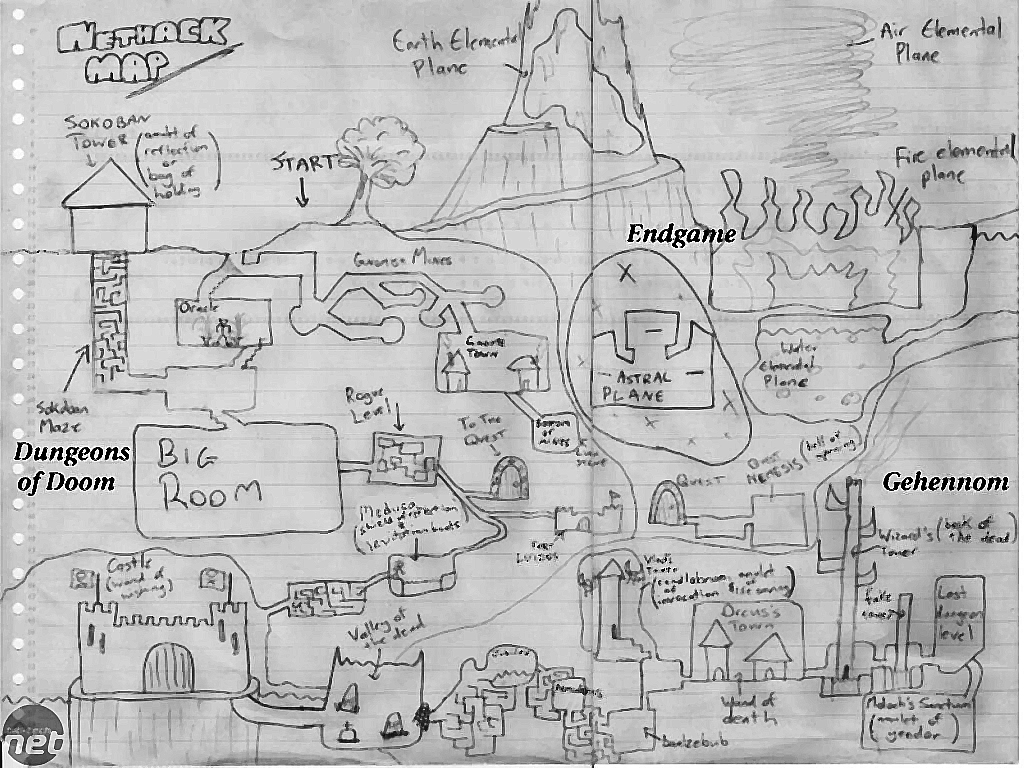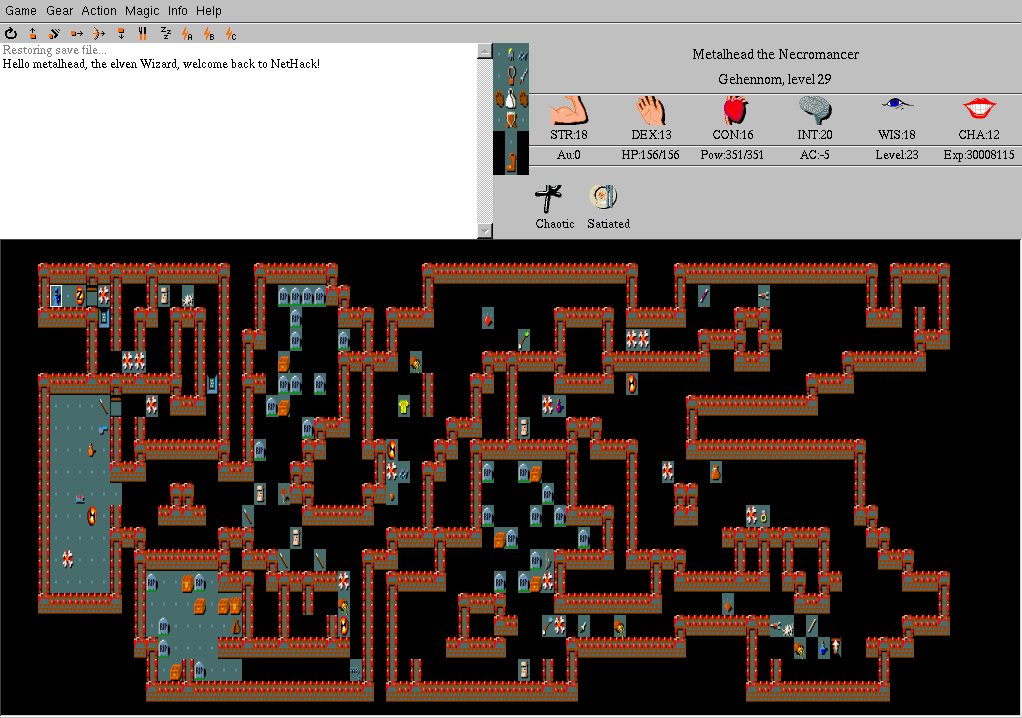The Every-Branching Universe: Forever Nethack
Saturday, January 16th, 2016
[Click on all images in this article to embiggen them]
You’re in the corner of a room that you can light up to half its length with your rapidly dying lantern. To your left you can see a scroll of charging, which you desperately need to replenish your wishing wand. To get to it, however, you have to bypass or eliminate the troll who is bashing you with its axe. If you kill it, you have to eat it quickly enough to prevent its resurrection. There’s also a trapdoor just in front of the charging scroll. To avoid it, you can either put on your ring of levitation or dig through the side wall with your pick axe. If you put on the ring, you need to take it off to pick up the scroll (this will occupy two moves). If you use the pick axe, you cannot wield your weapon at the same time.
While you are hacking at the troll with your life-draining Stormbringer, you are also trying to avoid trampling your tame cat, who’s frisking around you and whom you wish to keep alive long enough to polymorph into a friendly dragon that you can use as both weapon and steed. If you get the charging scroll, you can replenish your wishing wand and get a wand of polymorph. You’re also trying to block the unruly critter from falling into the trapdoor, because by the time you find it again at another dungeon level it will have forgotten you and turned feral.
Speaking of dragons, a black one just entered the dark area of the room. You know its presence and color because it’s breathing death at you; thankfully, your shield of reflection protects you and your inventory from being turned to dust. You could zap the beast with your wand of cancellation and reduce its deadly breath to harmless coughing. However, you want to kill it unmodified if possible, because eating it will make you disintegration-proof. But if you eat both the troll and the dragon, you’ll choke from overeating. If you pray to your patron god, (s)he may come to your aid. You feverishly rack your memory: did you offer enough at the last altar you passed?
Complicated, you say? Multiply this situation by a few hundred thousand times, and you get the feel of Nethack.
RPG games, now extraordinarily sophisticated in form (though still mostly primitive in content), have been enduring parallel universes for the armchair warriors who prefer their human contacts minimal, their muscles small and their repartee absent. Yet after all this programming effort, all the glitzy, expensive packages and X-boxes, after all the network chat groups and all the pneumatic avatars of Second Life, the most immersive, most addictive adventure game is an evolved species of the original sparse but nifty Rogue: Nethack.
Entirely keyboard-driven with ASCII characters, without any sound or special effects, Nethack can wreck careers and relationships — and like a truly dangerous drug, keep its victims blissed out while their world crumbles around them. And the main reason for the denomic hold of this game (besides the fact that it’s free and open source) is the same that makes books so infinitely superior to any flat-footed explicit representation: namely, Nethack uses human imagination as its engine, thereby turning what looks like a horse-driven cart into an FTL starship.
Nethack has been around since the mid-eighties, though it took a while to attain its full complexity. Like all D&D style games, it’s a Tolkienesque stew with side helpings of several other pop mythologies (the archaeologist class is a nod to Indiana Jones; one of the named weapons is Elric’s Stormbringer, another is Bilbo’s Sting; the quest homebase of the tourist class is a hat tip to Terry Pratchett… you get the gist). What makes it unusual is the heroic lengths to which the huge development team went to anticipate and program all possible actions within the framework. You can drink a potion – but you can also throw it, or dip something in it. A cockatrice can turn you to stone, but if you kill it and have gloves on you can wield it as a weapon to turn your enemies to stone instead. And what makes it amazing is how many ways the story can go, how richly textured it is, and how much it rewards exploration and strategy. It’s like seeing the multiverse concept in action, including the wavefunction collapse at the narrow-funnel ending. Nethack is a labor of immense love and a triumphant example of effective collective effort – the cyber-equivalent of a great bridge or temple.
I started playing Rogue in the mid-eighties – half of my then-lab were aficionados who watched others dodge medusae and xorns with the passionate involvement (and exclamations) usually vouchsafed to group-watching of football or soccer games. I then moved to the more complicated versions – Moria, Angband, and finally Nethack itself (plus the Zork series, of which Nemesis is my hands-down favorite because it has a plot and characters that I cared for). I’ve played all classes, races and alignments in Nethack, but have never completed a game except in immortal mode, which should give a hint of how fiendishly hard it is. And I still feel the thrill of anticipation whenever I go up or down a dungeon level staircase.
Nethack had not been altered in a while, except for its tiles version becoming (grumble) inoperative in MacOs systems past the big-cat-named ones. But this December version 3.6.0 appeared and, of course, all of us devotees ran over to see what’s new. Not surprisingly, only details have changed – the game is too fine-tuned to allow much further tinkering. Gehennom levels are now of two types instead of one; vampires have become more interesting. But I have a sneaking suspicion I will now replay all class/race combinations and class-specific quests, to check if something really new has been stealthily implemented Easter-egg fashion.
The only other games of this type that have come as close to captivating me as Nethack are Eschalon and, to a lesser extent, Legend of Pandora. A few others have lodged in my long-term memory: I wept at the end of Syberia, when the mammoths came out of the mist; I fell utterly in love with the atmospherics, worldbuilding (and strong women) of Sins of the Fathers and Broken Sword; and I adored witty, sui generis efforts like System’s Twilight, The Tiny Bang Story and Botanicula. I may at some point play Mass Effect (though the reports of its notoriously bad ending have given me pause, plus watching The Expanse may fill that need slot for me) or one of Assassin’s Creed – if the upcoming movie version with Michael Fassbender and Marion Cotillard is good enough to make me curious.
But no matter what shiny baubles come along, few hold my interest for long. Nethack has been the granite foundation of my gameplaying, my faithful companion in the sleepless watches of the night.
Related Articles:
The (Game)play’s the Thing: The Retro-RPG Eschalon
Mediterranean Diasporans: Dúrin’s Folk
Images: 1st, the unadorned Nethack screen appearance; 2nd, a charmingly handmade (but thorough) global Nethack map from BT-Net; 3rd, the start of Gehennom in Nethack (tile version)



